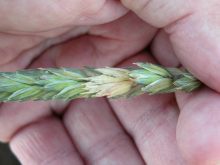The Canadian Grain Commission (CGC) is conducting a major review of grain grading.
That’s prompting calls by some for specifications to replace grades, while others say they’ll consider changes if they don’t undermine the current system or cost too much.
- Read more: Column roils wheat grading controversy
- Read more: Grading system needed to ensure proper compensation
Read Also

Manitoba sclerotinia picture mixed for 2025
Variations in weather and crop development in this year’s Manitoba canola fields make blanket sclerotinia outlooks hard to pin down
“Our goal with this review is to ensure that grain grades are evaluated using more effective, precise and user-friendly tools where possible,” Remi Gosselin, the CGC’s manager of corporate information services, said in an interview Nov. 14. “It’s about making sure our grain grading system continues to provide consistent and reliable results.
“It also needs to make sense from a dollars-and-cents perspective.”
The CGC announced the review last month to its grain standards committees, which will assist in the project, Gosselin said.
Wide representation
The committees are made up of representatives from the grain sector, including farmers, grain exporters, processors and grain quality experts.
The committees, created in 1930, meet in the spring and fall to discuss grain quality and tweak grades.
“We are reviewing the purpose and validity of the fusarium damage grading factor, which was established and defined a couple of years ago, as well as all grading factors, which are part of the grading tables, to confirm their relevance,” Gosselin said.
The Alberta Wheat Commission and Western Canadian Wheat Growers Association (WCWGA), have been calling on the CGC to introduce more objective tests to measure grading factors, including falling number, which assesses bread-making properties in wheat and DON (deoxynivalenol), a toxin that sometimes follows fusarium head blight infections in wheat and other cereals.

Currently sprout- and fusarium-damaged kernels are used as quick, visual proxies to reflect the impact on end-use functionality. But some years proxies aren’t as accurate as desired.
That was the case last crop year, with fusarium-damaged kernels (FDK) versus DON tests.
In 2005 the Canadian Wheat Board proposed falling number be an official grading factor instead of sprout damage. Falling number is calculated by recording the time it takes a plunger to fall in a test tube containing a slurry of water and wheat flour. The faster the plunger falls, the lower the viscosity of the solution and the poorer the bread-making quality.
Falling number is an internationally recognized proxy for determining alpha amylase, the enzyme that affects breadmaking.
Measuring falling number is time consuming. Machines such as the Rapid Visco Analyzer, do it faster. The CGC studied the machines a decade ago but found they weren’t accurate enough outside a laboratory.
The Western Grain Elevator Association (WGEA) saw potential for driveway falling number tests, but decided the expense wasn’t worth it, especially without accurate results.
Objectivity
The WCWGA welcomes the review, calling the current grading system “subjective,” in a Nov. 14, news release. Specifications would be more “transparent,” the WCWGA said.
“Farmers would benefit from a more honest grading system as they would be paid for the true value of their grain.”
Grain companies can and do buy grain on specifications, but usually on a case-by-case basis, relying more on grades in farmer transactions, WGEA executive director Wade Sobkowich said in an interview Nov. 14.
Grain companies usually sell grain based on customer specifications, but Canada’s grain grading system helps make the bulk grain-handling system more efficient, while helping farmers too, Sobkowich said.
“We like the grading system because it allows us to buy in an organized way,” he said. “It allows us to give the farmer a grade at the time of delivery. And it allows us to keep various quality parameters segregated in a bulk handling system. So that works for us. But we’re open minded about the future of the grading system.”
Changes to grading won’t result in a net gain in farmer revenue, he added.
“This is a zero-sum game,” he said.
More costly?
And there’s a possibility farmers could end up with lower returns because of the higher costs of testing falling number instead of a visual inspection for sprout damage on deliveries.
The WCWGA says grain company competition will prevent passing extra costs to farmers.
Terry Boehm said that’s “totally naive.”
“This will cost farmers,” Boehm, a former National Farmers Union president and Colonsay, Sask. farmer, said in an interview Nov. 14.
Dropping grades would result in less transparency too, Boehm said.
“In the early years of the grain trade it was very quickly understood that you needed some sort of grading system so people on each end of the transaction know what’s going on and have something to deal on,” he said.
“This is another reason grades were established — to assist in the pricing mechanism. The two go hand in hand.”
Specifications have so many variables price comparisons would be futile.”
Boehm also said the Canadian Grain Commission, as an institution, was built and mandated to act in the interests of grain producers and to ensure a dependable commodity for export and domestic use. He described the grading system as “integral” to fulfilling that mandate.
He also lamented the loss of flexibility and transparency the proposed changes may result in, noting that under the current system farmers always have the option of asking the grain commission to determine the grade.
The grading system isn’t as subjective as some think, Gosselin said. While some grading factors are assessed on visual appearance, the damage is tied to research that has determined the impact on end use.
Samples of various types of damage are also made every year as a reference for inspectors.
The same applies for various grain grades.
“This is a major review but it doesn’t necessarily mean we will be making foundational changes,” he said.
Millers rely on Canada’s quality control system, including grading, Gordon Harrison, president of the Canadian National Millers, said in an email Nov. 14.
“Given the criteria in the Canadian system for variety licensing, end-use performance determinants and transparent determination of protein levels, it is curious to say the least that some organizations representing producer interests continue to advocate the dismantling of the wheat quality assurance system,” he wrote. “This is a system that defines value for millers and other processors in Canada, U.S., Mexico, and traditional offshore markets that represent demand for billions of dollars in wheat exports annually, predominantly of western Canadian origin.”




















